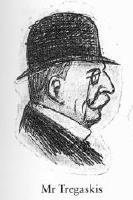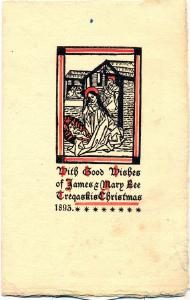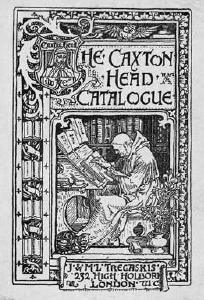James Tregaskis

James Tregaskis (1850-1926) became the fourth ABA president in 1910 – but was the first president not born in London and the first not to have been born into the trade. In fact, he did not become a bookseller until he was almost forty. From there, he rose to become one of the leading booksellers in the world and to reach the very pinnacle of the trade.
His story is a slightly curious one. He was born on 23rd April 1850 at St. Day, a village not far from Redruth in Cornwall – the son of James Tregaskis and his wife, Fanny Blenkinsop, who had married in 1847. His father was a local printer and stationer in a modest way of business, and it was as a printer that Tregaskis trained, serving an apprenticeship in London and joining his uncle's business Blenkinsop & Co., in Well Court, off Bow Lane in the City of London, becoming a master printer and then a partner in 1879. He remained a partner until the end of March 1889. A court case the following January revealed that he had been the victim of an accident – a falling plank had badly injured his foot, causing the amputation of one toe and the partial loss of another. He sued the builders, revealing that it was his injury and consequent loss of health which had necessitated giving up the partnership. According to the London Daily News of 24th January 1890, he was awarded £450 in damages.

He had apparently been passionate about old books for some time before this, and at that point he retired from printing and went to work in his wife’s bookshop. He had married Mary Lee Bennett (1854?-1900) in August 1887. She was the daughter of George Lee, a relatively prosperous Northumbrian boat-builder and his Scottish wife Ann Mitchel – and the widow of William Parsons Bennett (1838?-1886). Bennett is a little obscure, but evidently worked as a partwork publisher with addresses in Birmingham and London until his bankruptcy in 1880. He had married Mary Lee in Yorkshire in 1876 and, after the bankruptcy, having somehow acquired the stock of Robert Wilde of Birmingham, set up as a bookseller at 39 Great Russell Street in London – this the shop that Henry Newton Stevens, the first ABA president, was soon to take over. After Bennett’s death in July 1886, Mary Lee Bennett inherited an estate valued at £674.7s.9d and continued the business, soon moving to the shop at 232 High Holborn which was to become famous as “The Caxton Head”, home of the new firm of “J. & M. L. Tregaskis”.

The couple had a great flair for publicity, promoting the business through frequent and attractive catalogues and a series of innovative exhibitions, such as the 1894 exhibition of seventy-three copies of the Kelmscott Press (William Morris was a customer) Tale of King Florus and the Fair Jehane in unique bindings from twenty-seven different countries. The complete collection is now in the Rylands and it was the publicity generated by this exhibition which led to a royal summons to Windsor to show the books to Queen Victoria.
Here is how William Roberts reported on their progress in The Book-Hunter in London in 1895 – “The chief and most enterprising firm of booksellers in Holborn proper is that of Mr. and Mrs. Tregaskis, at No. 232, the corner of the New Turnstile ... . Mrs. Tregaskis first started, as Mrs. Bennett ... and some time after removing to her present shop, married Mr. James Tregaskis, and the two together have built up a business which is scarcely without a rival in London. The shop is literally crammed with rare and interesting books, whilst The Caxton Head Catalogues are got up with every possible care”.

Numerous Tregaskis catalogues, e.g. A catalogue of valuable manuscripts, rare & interesting books, and beautiful bookbindings offered for sale by J. & M. L. Tregaskis, at their house at the sign of the “Caxton Head” in High Holborn, London, A.D. 1898 are held by various major libraries. An early customer, later a good friend, was the redoubtable American collector, Alfred Edward Newton (1864-1940), who admitted that the arrival of a Caxton Head catalogue always suspended all business in his office for half an hour. From Tregaskis, among many other things, Newton acquired the copy of Memoirs of **** commonly known by the name of George Psalmanazar, a reputed native of Formosa given and inscribed to Mrs Thrale by Samuel Johnson (both Newton and Tregaskis were ardent Johnsonians) – and it was Newton who penned a brief memoir of Tregaskis for the 1,000th Caxton Head catalogue. Elsewhere he noted, “I ever and always found him to be a frank, generous and kindly host. Talk with a good bookseller can hardly be bettered, as all collectors know”. (The correspondence between Newton and the Tregaskis family is now in the Rare Book and Manuscript Department, Free Library of Philadelphia).
As well as making their reputation in these years, the couple were also starting a family. A son, James Richard Tregaskis, was born in 1888, followed by two daughters, Aldine Mary Lee Tregaskis in 1893, and Irmgarde Anna Tregaskis in 1894. The children were left motherless when Mary Lee Tregaskis died in her mid-forties in August 1900. A Cornish housekeeper was imported to run the household for a time, but in November 1903, James Tregaskis remarried. His second wife was Eveline Belwood Davis (1877-1948), daughter of the well-known Chelsea printseller, Alfred Davis (1840-1912) and his wife, Isabel Read. A son of the second marriage, Hugh Frederick Beresford Tregaskis, was born in 1905. Meanwhile the business went from strength to strength – it was reported in the press in 1901 that Tregaskis had just published his 500th catalogue, noting in the foreword that at the William Morris sale he had bought back an early edition of Hippocrates for £40.10s, which he had sold the poet some years earlier for eight guineas. And by now he was dealing in whole range of materials – the British Museum has some beautiful Japanese prints bought from Tregaskis, and even some elaborate oriental metal stamps and statuettes.

Success was evident and before too long a family home, Lawn House in Hampstead Square, was acquired. Tregaskis was a founder member of the ABA in 1906 – it was he who seconded the proposal that it be called theAntiquarian Bookseller’s Association, defeated at first in favour of the Second-Hand Booksellers’ Association, which was the original name for a couple of years.
The Caxton Head shop moved from High Holborn to 66 Great Russell Street in 1915, where it remained for the rest of his career. A fine description of the new shop (and the complexities and orderliness of moving the stock) was given in The Clique – "a happy change from darkness to light, from cramped and inconvenient show rooms and offices to spacious, elegant and dignified premises ... there is no doubt that the new 'Caxton Head' is the handsomest bookshop in the neighbourhood of the British Museum ... On entering the shop one feels more like entering a handsomely appointed private library. The walls in pure white enamel, the mahogany cases filled with the treasures Mr Tregaskis deals in, the artistic floor covering, with Persian rugs thrown down here and there, the beautifully carved Georgian mantels – all seem to invite one to take one of the antique chairs, extract a rare book from one of the cases, and forget everything, even the War".
<p style="text-align: right;"><em>Laurence Worms (June 2012, revised December 2012, with many thanks to Petronella Griffith and James Tregaskis, grand-children of James Tregaskis, for additional information on the family history). Further revised April 1914. August 2016.</em></p>
James Tregaskis died at Great Russell Street on 23rd November 1926 and was buried at St. John Hampstead a few days later. Probate was duly granted to his widow, Eveline Belwood Tregaskis – his estate valued at £8,371.6s.7d. His first son, James Richard Tregaskis, had died in 1914 and it is not clear whether he had any involvement in the business. Hugh Tregaskis (1905-1983) certainly did and appears to have become an ABA member in his own right at the age of fifteen in late 1920 – the name of the firm certainly became James Tregaskis & Son at this time. The house in Hampstead was given up, the family returning to live as well as work in Great Russell Street, and James Tregaskis, now seventy, was probably beginning to feel encroaching age. It was Hugh who continued the firm under the same name after his father’s death, although Eveline remained co-owner. The depression on the 1930s took a great toll on the rare book trade and the last Tregaskis catalogue I can trace appeared in 1937 [the run in the Bodleian ends with No. 1027 in 1837]. The firm resigned from the ABA in 1937 and the business folded in 1939. Hugh Tregaskis made a brief reappearance at another address in Great Russell Street after the war, but subsequently joined F. B. Daniell & Son in Cranbourne Street, the leading experts in English and French prints, eventually taking over the business, which ran until 1972. He continued buying and selling until his death in 1983 – sadly knocked down by a car while crossing the road and killed. He was the author of Beyond the Grand Tour : The Levant Lunatics (1979), as well as many articles, jokes and cartoons. Daughter Irmgarde Anna Tregaskis (1894-1958) married George Macmillan Young, an engineer, in 1915 and appears to have played no part in bookselling.
The elder daughter, Aldine Mary Lee Tregaskis (1893-1975), formally described herself as a bibliographer on the 1911 census return and remained in Great Russell Street until at least 1939, living with her step-mother. The Tregaskis firm was still listed in London telephone directories until that year and it was probably she who remained its guiding spirit until the end. She was on the Great Russell Street electoral roll in her own right from 1930 and in all probability, certainly given the youth of her half-brother when he joined the firm, may well have been responsible for a great deal of the Tregaskis cataloguing over a period of thirty years or more.
Laurence Worms (June 2012, revised December 2012, with many thanks to Petronella Griffith and James Tregaskis, grand-children of James Tregaskis, for additional information on the family history). Further revised April 1914. August 2016.
